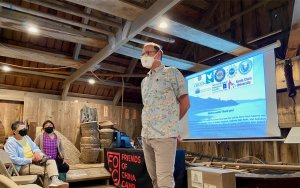
Digging into Coast Miwok history
Research on shellmounds at China Camp gives new insights into the region’s Indigenous peoples.
Digging is a regular feature of the work of China Camp’s trail-maintenance volunteers like me. Fences, signposts, and other structures need to be built, repaired, and replaced. When such work takes place in or near locations that archaeologists have deemed “culturally sensitive,” the digging frequently must be monitored by a representative of the Federated Indians of Graton Rancheria. That’s the federally recognized tribe that represents the Coast Miwok people, the Indigenous inhabitants of what is now Marin County, whose presence in the region stretches back thousands of years.
Until recently, my reaction to this kind of monitoring had been one of skepticism. I’d wonder if such requirements were merely a bureaucratic formality. After all, I surmised, the San Pedro Ridge landscape has been altered and remade by successive waves of settlers—Spanish, Mexican, European-Americans, and Chinese-Americans—over the past two centuries. The building of roads and settlements, draining of wetlands, farming, and ranching seemed to have nearly erased any evidence of the presence of the park’s Native population. Hadn’t they, as I’d understood from traditional histories, fled this and most other parts of Marin County well before the Gold Rush, caught between the vise of Spanish missions, land-hungry settlers, and Russian fur-hunters just up the coast?

A fascinating book has made me question this view, and to better understand China Camp as an essential part of Coast Miwok history and culture. In his book The Archaeology of Refuge and Recourse: Coast Miwok Resilience and Indigenous Hinterlands in Colonial California, Dr. Tsim D. Schneider, Assistant Professor of Anthropology at UC Santa Cruz, makes a convincing case for the continuing significance of China Camp and other places of “refuge” and “recourse” in the lives of Marin’s Coast Miwok.
Like many Native tribes, the Coast Miwok had been written off by previous generations of historians and archaeologists, seen as bound to vanish due to disease, violence, and the crushing impact of new cultures on Miwok lifestyle and traditions. However, as Dr. Schneider emphasizes in his book, the Miwok’s persistence and resilience saw them through the Spanish colonial period (1770s to 1830s) and beyond. This was in no small part due to the presence of their historic homelands offering refuge and protection, places where they could continue “to hunt, gather, weave, dance, sing, and conduct still other long-standing cultural practices,” says Schneider.
Moreover, notes Dr. Schneider who is himself a citizen of Graton Rancheria, these places sustaining Coast Miwok people and their culture in the past continue to offer deep cultural, historical, and spiritual meaning to them today.
To better understand this history, Dr. Schneider studied China Camp’s shellmounds. These spaces were once regarded as “garbage heaps” by white colonists. In fact, the mounds were the traditional sites of homes, burials, and rituals. Archaeological field work done by Dr. Schneider discovered that such locations were never truly abandoned in colonial times, as earlier researchers contended. Instead, deep-seated ties to place and a history of mobility meant that they remained as persistent and powerful Indigenous spaces, notes the author, “recalled and returned to for protection and empowerment … [and] gathering areas for Native people seeking to extract themselves from mission influence.”
So what exactly did Schneider find in his work on the shellmounds at China Camp? For me, this short excerpt captures the essence of the sites’ significance in Coast Miwok history and culture, right up to today.
“Under the canopy of bay and buckeye trees at China Camp, in the small piles of shell, earth, ash, and rock filling our archaeological sifting screens lay another rendering of time and place. … As residential spaces occupied for at least a thousand years, Coast Miwok would return to each mound for a variety of purposes—to celebrate life and death, construct homes, weave baskets, smoke tobacco, create sharp cutting tools, and to collect and process many hundreds of varieties of plants and shellfish, fish, waterfowl, and deer for food, medicine, and sundry other necessities. As missions began operating in the region, … access to traditional resources shifted to accommodate new social and economic connections. It did not end. As places of refuge and center points, some shellmounds may have afforded protection to Coast Miwok by anchoring contingent social networks and cultural identities during the colonial era. … [M]y analysis and comparison of multiple forms of evidence—archaeological, ethnographic, and archival—help give shape to a broader landscape that was continually inhabited, memorialized, and rendered meaningful. I see the persistence of time and place in the dusty layers of three unassuming shellmounds.”
Thanks to Dr. Schneider’s research and insights, I have a newfound respect for the history embedded in the land. I have also gained a deeper understanding of the importance of California State Parks’ partnership with the Federated Indians of Graton Rancheria, who play a crucial role in protecting the park’s cultural resources. Honoring and respecting the mostly unseen heritage of the Coast Miwok seems worth the extra care and regulations applied to ongoing maintenance projects in the park. The Archaeology of Refuge and Recourse has certainly “rendered meaningful” to me the Indigenous history beneath the landscape of what is now China Camp State Park.—by Kevin Smead, FOCC volunteer
———————————————————————————————————————
Schneider, Tsim D. 2021. The Archaeology of Refuge and Recourse: Coast Miwok Resilience and Indigenous Hinterlands in Colonial California. University of Arizona Press, Tucson.

